AMD Kaveri Review: A8-7600 and A10-7850K Tested
by Ian Cutress & Rahul Garg on January 14, 2014 8:00 AM ESTIntegrated GPU Performance: Sleeping Dogs
Sleeping Dogs is a benchmarking wet dream – a highly complex benchmark that can bring the toughest setup and high resolutions down into single figures. Having an extreme SSAO setting can do that, but at the right settings Sleeping Dogs is highly playable and enjoyable. We run the basic benchmark program laid out in the Adrenaline benchmark tool, and their three default settings of Performance (1280x1024, Low), Quality (1680x1050, Medium/High) and Xtreme (1920x1080, Maximum) noting down the average frame rates and the minimum frame rates.
Sleeping Dogs, Performance Settings
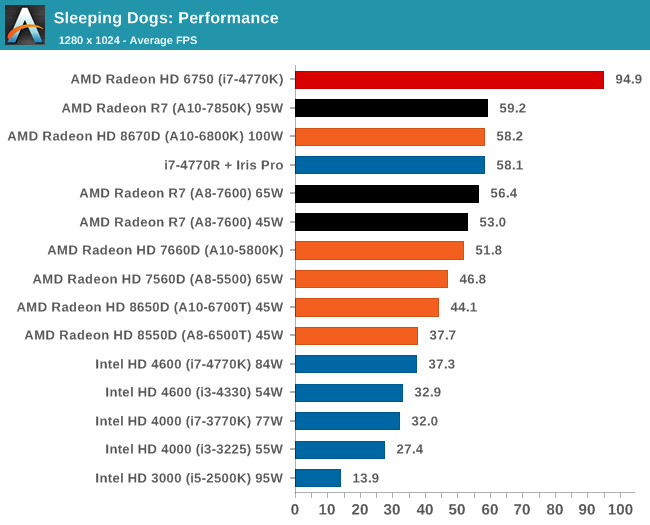
All the AMD APUs tested for this review manage to go above 30 FPS for Sleeping Dogs, with the top end APU nudging at the door of 60 FPS average.
Sleeping Dogs, Quality Settings
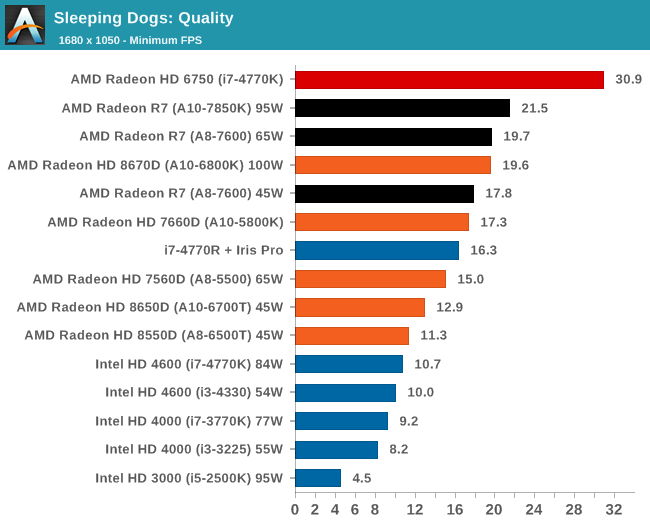
The GCN based Kaveri take the top two IGP spots, and Iris Pro is moving down the list by comparison.
Sleeping Dogs, Xtreme Settings

Iris Pro struggles a lot at 1080p in Sleeping Dogs.
Integrated GPU Performance: Company of Heroes 2
The final gaming benchmark is another humdinger. Company of Heroes 2 also can bring the house down, even at very basic benchmark settings. To get an average 30 FPS at any settings using integrated graphics is a challenge, let alone a minimum frame rate of 30 FPS. For this benchmark I use modified versions of Ryan’s batch files more suited for integrated graphics: 1280x1024 on minimum; 1680x1050 on Low and 1920x1080 on Medium.
Company of Heroes 2, Performance Settings
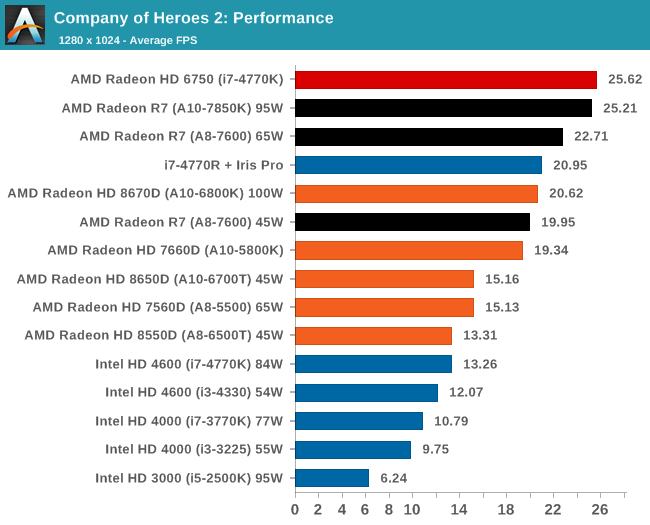
COH2 is demanding enough that even at 1280x1024 and low settings, no platform we tested today can hit 30 FPS average. The 95W Kaveri part does however outshine Richland by almost 25%.
Company of Heroes 2, Quality Settings
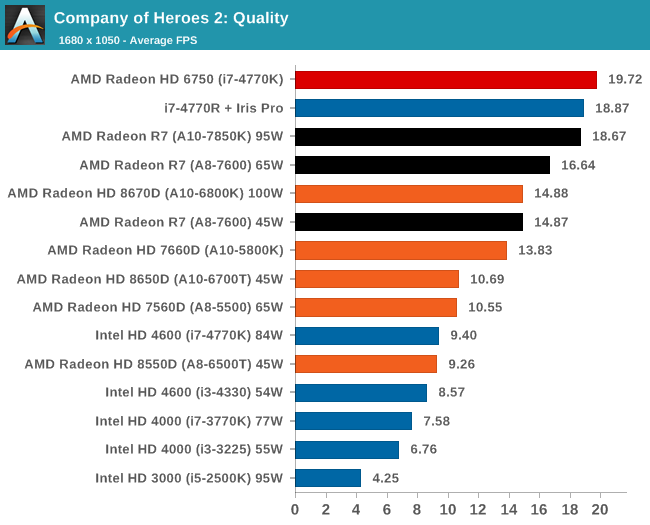
Company of Heroes 2, Xtreme Settings
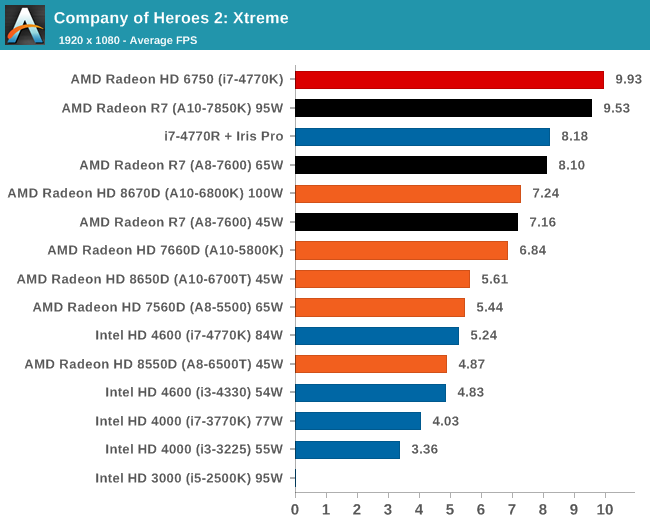
With COH2 extreme settings, the Intel solutions are moving up the minimum FPS ranks to beat AMD.










380 Comments
View All Comments
geniekid - Tuesday, January 14, 2014 - link
Would've been nice to see a discrete GPU thrown in the mix - especially with all that talk about Dual Graphics.Ryan Smith - Tuesday, January 14, 2014 - link
Dual graphics is not yet up and running (and it would require a different card than the 6750 Ian had on hand).Nenad - Wednesday, January 15, 2014 - link
I wonder if Dual Graphics can work with HSA, although I doubt due to cache coherence if nothing else.While on HSA, I must say that it looks very promising. I do not have experience with AMD specific GPU programming, or with OpenCL, but I do with CUDA (and some AMP) - and ability to avoid CPU/GPU copy would be great advantage in certain cases.
Interesting thing is that AMD now have HW that support HSA, but does not yet have software tools (drivers, compilers...), while NVidia does not have HW, but does have software: in new CUDA, you can use unified memory, even if driver simulate copy for you (but that supposedly means when NVidia deliver HW, your unaltered app from last year will work and use advantage of HSA)
Also, while HSA is great step ahead, I wonder if we will ever see one much more important thing if GPGPU is ever to became mainstream: PREEMPTIVE MULTITASKING. As it is now, still programer/app needs to spend time to figure out how to split work in small chunks for GPU, in order to not take too much time of GPU at once. It increase complexity of GPU code, and rely on good behavior of other GPU apps. Hopefully, next AMD 'unification' after HSA would be 'preemptive multitasking' ;p
tcube - Thursday, January 16, 2014 - link
Preemtion, dynamic context switching is said to come with excavator core/ carizo apu. And they do have the toolset for hsa/hsail, just look it up on amd's site, bolt i think it's called it is a c library.Further more project sumatra will make java execute on the gpu. At first via a opencl wrapper then via hsa and in the end the jvm itself will do it for you via hsa. Oracle is prety commited to this.
kazriko - Thursday, January 30, 2014 - link
I think where multiple GPU and Dual Graphics stuff will really shine is when we start getting more Mantle applications. With that, each GPU in the system can be controlled independently, and the developers could put GPGPU processes that work better with low latency to the CPU on the APU's built in GPU, and processes for graphics rendering that don't need as low of latency to the discrete graphics card.Preemptive would be interesting, but I'm not sure how game-changing it would be once you get into HSA's juggling of tasks back and forth between different processors. Right now, they do have multitasking they could do by having several queues going into the GPU, and you could have several tasks running from each queue across the different CUs on the chip. Not preemptive, but definitely multi-threaded.
MaRao - Thursday, January 16, 2014 - link
Instead AMD should create new chipsets with dual AMU sockets. Two A8-7600 APUs can give tremendous CPU and GPU performance, yet maintaining 90-100W power usage.PatHeist - Thursday, February 13, 2014 - link
Making dual socket boards scale well is tremendously complex. You also need to increase things like the CPU cache by a lot. Not to mention that performance would tend to scale very badly with the additional CPU cores for things like gaming.kzac - Monday, February 16, 2015 - link
Having 2 or more APUs on a logic board would defeat the purpose of having an APU in the first place, which was to eliminate processing being handled by the logic board controller. With dual APU sockets, there would need to be some controller interjected to direct work to the APUs which could create a bottle neck in processing time (clock cycles). This is the very reason for the existence of multi core APUs and CPUs of today.Its my expectation that we will start to observe much more memory being added to the APU at some point, to increase throughput speeds. Essentially think of future APUs becoming a mini computer within, the only limitations currently to this issue are heat extraction and power consumption.
5thaccount - Tuesday, January 21, 2014 - link
I'm not so interested in dual graphics... I am really curious to see how it performs as a standard old-fashioned CPU. You could even bench it with an nVidia card. No one seems to be reviewing it as a processor. All reviews review it as an APU. Funny thing is, several people I work with use these, but they all have discrete graphics.geniekid - Tuesday, January 14, 2014 - link
Nvm. Too early!